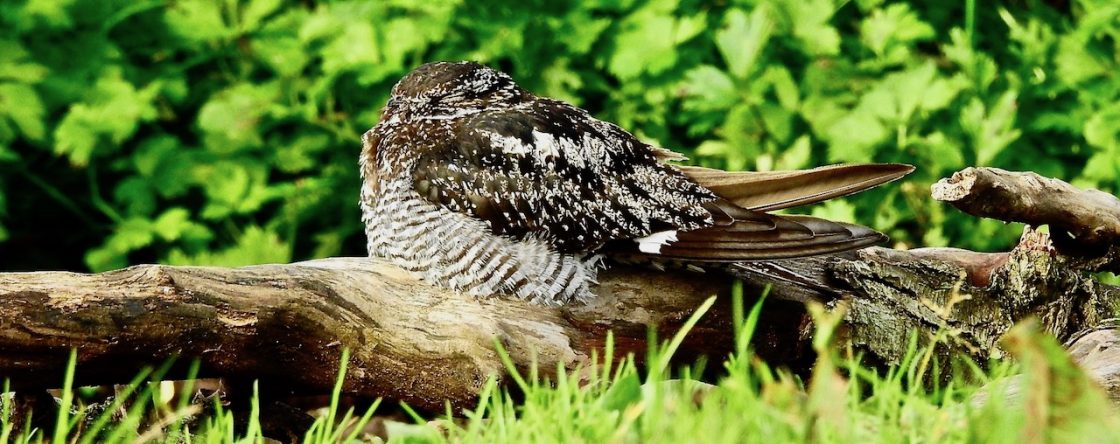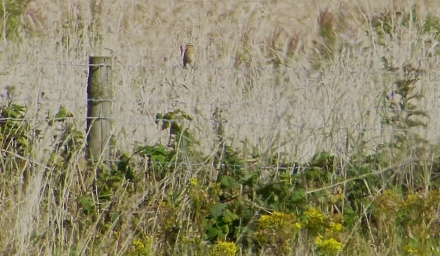Can’t beat a hot September afternoon seeing what’s moving through the coastal scrub.
We all have our favourite spots – mine is a sheltered area of Black Poplar, Hawthorn and Elderberry near the end of Range Lane, Formby.
With Cabin Hill to your back and Migrant Hawkers exuding effortless cool overhead, it’s a great place to spend an autumn hour or two watching what comes out of the foliage.
Nothing startling today, but 8-10 Chiffchaff, 1 male Blackcap, 3 Willow Warbler, Goldcrest, Treecreeper and an assortment of Long Tailed, Great and Blue Tits, with Chaffinches rattling through the drying leaves, kept me looking, until a male Sprawk tazzed through and put an end to the afternoon’s entertainment.
On the way down, the gorse and ragworty field at the end of Range Lane held the hyperactive and fully-fledged Stonechat family (4-5 birds), 3 Whitethroat and a nice, albeit distant Whinchat (squint hard at the pic above and you may be able to see it).
4 Common Buzzard mewling and thermalling over Cabin Hill.
Butterflies in the hot sun included Peacock, Red Admiral, Large White, Common Blue and Speckled Wood.



Lovely account as ever. When I first looked at the pic of the Whinchat I thought I was looking at the wall of a stone cottage. If you look at the fence post it could almost be a door in a wall. Yes, I know – I’d better go to Specsavers!!
LikeLiked by 1 person
Approximately 100 hirundines, mainly House Martins, hawking over the frontal dunes at Ainsdale in the thick mist this morning. Reed Bunting numbers increasing too.
LikeLike
Yellow Wagtail seen tonight by the compost site near Little Altcar.
LikeLike
Garden dragonflies were slow to emerge this year, according to preliminary British Trust for Ornithology (BTO) Garden BirdWatch results. Reports of common garden dragonflies, such as Large Red Damselfly, peaked much later this year than in previous years, possibly due to the bad weather at the start of the summer. Will this poor summer affect their numbers next year?
Many of our common garden dragonfly species emerge as adults in June and July, spend a few weeks on the wing, lay their eggs and then die. Our most common garden dragonfly is the Large Red Damselfly, which in 2013 was seen in 15% of Garden BirdWatch gardens at its peak in late May. It is one of the earliest emerging dragonflies and usually peaks in May, but this year it only reached a peak of 12% and not until early June, a week later than witnessed in 2014.
The Large Red Damselfly was not the only dragonfly to attain its peak later than in previous years. The Common Blue Damselfly was seen at its highest peak this year, in 10.4% of Garden BirdWatch gardens, but peaked three weeks later than in 2014, in early July. This pattern was also seen in Azure Damselfly, which is usually most common in June.
It wasn’t all bad news, however. Some of our hawker species, which are rarer in gardens, followed patterns similar to previous years, suggesting that it must have been adverse weather that affected the early emerging species.
Clare Simm, from the Garden BirdWatch team, commented, “It’s been a poor summer for many species, not just dragonflies, as the bad weather hit at a key time of year. As you can see, our volunteers do not just focus on birds, but also provide us with vital information on other wildlife groups too which help us understand how gardens are used by different species.”
Will this summer’s results affect how dragonflies do next year? We need your help to find out.
Get in touch for a free BTO Garden BirdWatch information pack which includes a copy of our quarterly magazine. Email gbw@bto.org, telephone 01842 750050, or write to GBW, BTO, The Nunnery, Thetford, Norfolk, IP24 2PU. For more information about BTO Garden BirdWatch, visit http://www.bto.org/gbw
LikeLike
One of Britain’s most threatened seabirds, the little tern, has successfully nested at the RSPB Point of Ayr nature reserve on the Dee Estuary for the first time since the 1960s.
Staff and volunteers were delighted to discover one pair successfully nested on the reserve, while 136 pairs also nested this year at a nearby large colony at Gronant, which has been managed for over 30 years by the RSPB and for the last decade by Denbighshire County Council. A five year pot of funding from the EU was awarded in 2013 in an attempt to reverse the fortunes of the declining colonies of these delicate birds in England and Wales.
Meanwhile the Point of Ayr soon becomes a hotbed for wetland birds over the winter months, acting as a vital home for thousands of wading birds and ducks at high tide. The RSPB Dee Estuary team is leading an Autumn Arrivals event on Saturday 31 October, to showcase this spectacle from the hide overlooking the reserve.
Autumn Arrivals is free of charge, but donations are gratefully received on the day. Booking in advance is advisable as places are limited. Full details can be found at the website http://www.rspb.org.uk/pointofayr or call Burton Mere Wetlands on 0151 353 8478 for more information.
LikeLike
Got the Wryneck this morning at Fairhaven, not great views but nice to see. Adult Med Gull this evening on Hillside Practice Green viewable from Birkdale LNR, perhaps the one that’s been knocking about on and off for a while. 3 Curlew still feeding on there too.
LikeLike